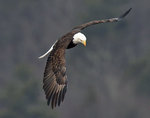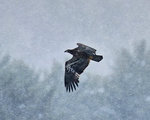 Narrowsburg
NarrowsburgLight Rain Fog/Mist, 43°
Wind: 8.1 mph
 Narrowsburg
NarrowsburgWhen January rolls around, people think about watching eagles at favorite viewing spots along ice-free water.
Stay informed about your community and support local independent journalism.
Subscribe to The River Reporter today. click here
This item is available in full to subscribers.
Please log in to continue |


When January rolls around, people think about watching eagles at favorite viewing spots along ice-free water.
In this region, the Delaware and Mongaup Rivers are renowned for winter eagle-sightings. Eagles from Canada come down and spend the winter. The waterways at eagle breeding areas up north are frozen, and since bald eagles are primarily fish eaters, the birds come here, taking advantage of the ice-free portions of rivers to forage.
Migrating eagles actually show up earlier in the area; peak counts on Sunrise Mountain and other ridges, where raptor migration counts are performed, show that bald eagles are passing through in October and November. A lesser number of golden eagles can be observed migrating past these ridges during the same time period.
Studies utilizing satellite telemetry by the New York State Department of Environmental Conservation and other wildlife agencies show that eagles take breaks in favorable habitats along their migration routes. The birds forage and rest for a brief period before resuming the trip to wherever their wintering grounds lie.
The reason that more eagles are not seen earlier in the fall, compared to the numbers seen in the middle of winter, is that rivers and lakes are still ice-free. This means that eagles have many more sections of waterway to forage for fish.
Eagles are still around earlier in the fall, but you have to travel further up and down the river to see them.
This January has been mild, so this scenario is playing out, as there is little or no ice on the rivers.
The trick to finding eagles is to think about food. Eagles are opportunistic feeders and take advantage of feeding opportunities, whether they are natural or man-made. The Lackawaxen River is downstream of a hydroelectric dam at Lake Wallenpaupack; when the facility is generating electricity, alewives—small fish—get stunned or killed by the turbine blades. These fish float downstream and create feeding opportunities for eagles. Portions of the Mongaup River are similar.
Augmenting the wintering eagle population are the local resident breeding eagles, with territories along the region’s rivers and lakes. The resident eagles stay in the area all year, though they venture out of their territory a lot during the winter during their non-breeding time.
A banded eagle that had a nest on the Delaware was observed at Mongaup Falls. In 1993, a pair of breeding eagles was observed on the upper Delaware corridor, the first since before the massive population decline due to DDT. At the moment, there are at least 21 active breeding territories along the same stretch of river.
There has been a significant increase in eagles in both PA and New York in the last couple of decades. If you go out eagle watching, there is now a greater likelihood that some of the eagles you see this winter are part of a resident breeding pair.
Comments
No comments on this item Please log in to comment by clicking here